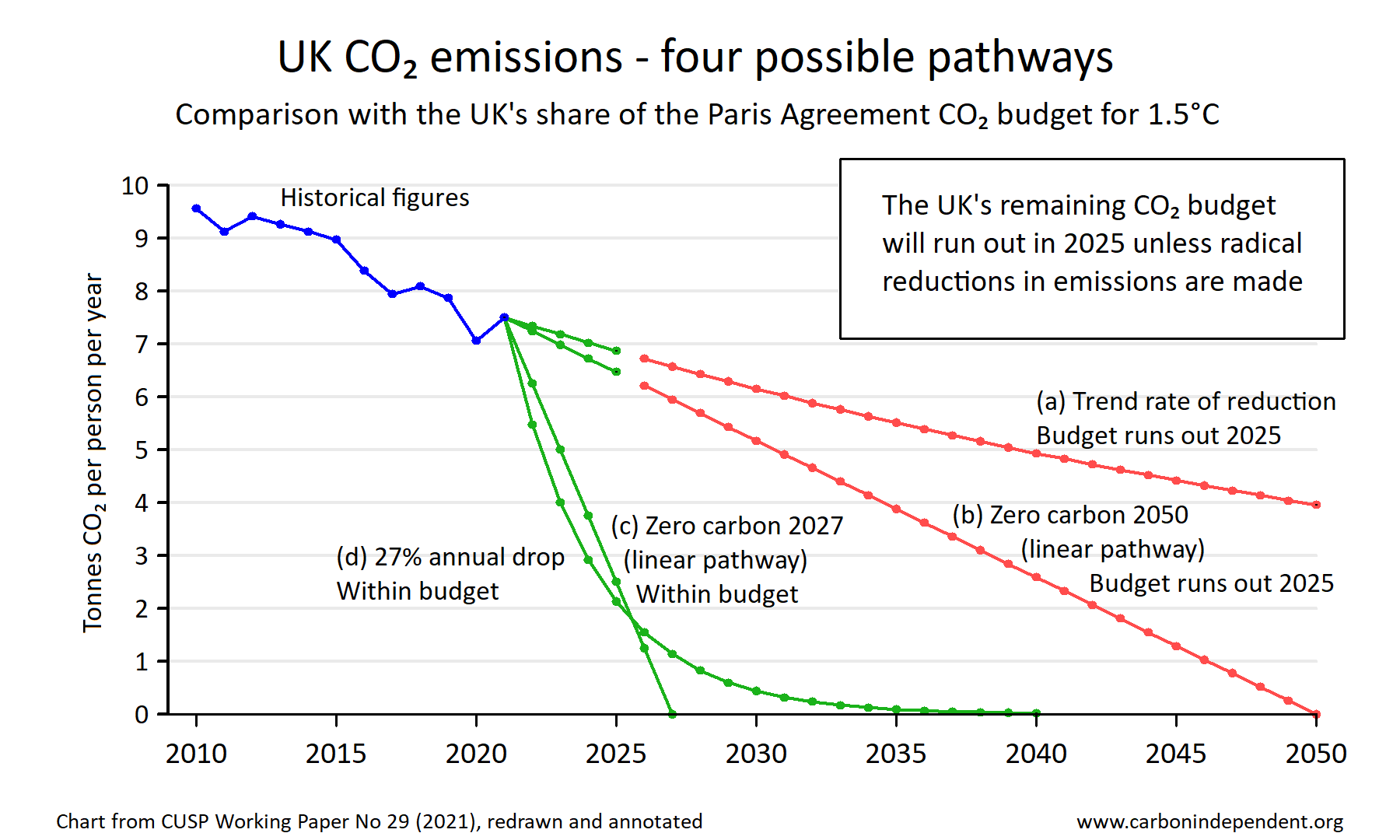
"Zero carbon sooner" CO2 budget report from CUSP
 This is a commentary on a report on the UK's CO2 budget titled Zero carbon sooner by Prof Tim Jackson of the Centre for the Understanding of Sustainable Proposperity (CUSP) at the University of Surrey.
This is a commentary on a report on the UK's CO2 budget titled Zero carbon sooner by Prof Tim Jackson of the Centre for the Understanding of Sustainable Proposperity (CUSP) at the University of Surrey. It was published in 2021 following the publication of the IPCC's AR6 WG1 report.
The main points are that
- the UK Government's timescale of cuts in CO2 emissions is grossly inadequate
- instead, to meet the UK's international commitments, immediate radical emission cuts of over 20% annually are needed.

The conclusions of the report
In its preferred analysis, the report concluded:
- At the current trend (line (a) in the chart), or via the net zero 2050 steady reduction (line (b)), the UK's per capita "fair share" of the residual global CO2 budget will be used up in 3 years, i.e. in 2025.
- By reducing emissions rapidly, the UK's fair share of the CO2 budget can be made to last to 2027, if the pathway is a steady (straight line i.e. linear) decline - line (c).
- The UK's fair share of the CO2 budget can be made to last beyond 2027, but only if emission cuts are even steeper, e.g. a 27% year-on-year decline - as in line (d).
- The UK Government's Net Zero 2050 strategy would lead to the UK emitting several times its fair share of the residual CO2 budget.
- To merely specify the net zero date of a strategy is insufficient, the pathway of emission cuts is crucially important.
About CO2 budgets
The remaining CO2 budget is the total amount of carbon dioxide (CO2) that can be emitted into the atmosphere from now until a state of net zero emissions is reached.
Starting points in the report
- the aim is to keep global warming below 1.5°C with 67% likelihood
- the IPCC gives 400 billion tonnes CO2 as the remaining global carbon budget for this aim [1]
- this global carbon budget should be divided between countries on a per capita basis, with a reduction for the UK of 14% to allow for its current emissions being well above the average
- all emissions due to UK residents should be included, including via purchase of imports.
Implications of the report
- There is a wide disparity between the UK Government's Net Zero 2050 approach and what it is committed to via the Paris and other agreements.
- Many campaigning groups are out of step with the climate science - exceptions are the youth climate activists and Extinction Rebellion (with its net zero 2025 demand).
- Society in general is unaware of the urgency of the climate emergency, and of the size and speed of changes needed.
Related studies
- The Tyndall Climate centre has produced reports for each UK local authority, with broadly similar conclusions [2]
- The website https://carbonbudgetcalculator.com gives pathways for various starting points and countries (but does not include imported goods).
- Charts similar to the one shown from the CUSP report have been published at frequent intervals for many years. This chart [3] was published in 2018 in the Global Carbon Budget 2018 [4].

Links to the report
- Prof Tim Jackson's introductory text: https://timjackson.org.uk/zero-carbon-sooner-update/
- PDF: https://cusp.ac.uk/wp-content/uploads/WP-29-Zero-Carbon-Sooner-update.pdf.
References
| [1] | IPCC (Aug 2021) AR6 Climate Change 2021: The Physical Science Basis https://www.ipcc.ch/report/ar6/wg1/ |
| [2] | Tyndall Centre The Tyndall carbon budget tool (2019) https://carbonbudget.manchester.ac.uk/reports/ |
| [3] | https://folk.uio.no/roberan/img/GCB2018/PNG/s00_2018_Mitigation_Curves_1.5C.png |
| [4] | Figures from Global Carbon Budget 2018 https://folk.universitetetioslo.no/roberan/GCB2018.shtml |
First published: 24 Feb 2022
Last updated: 16 Aug 2023

 ✖
✖